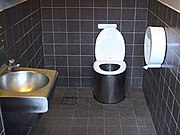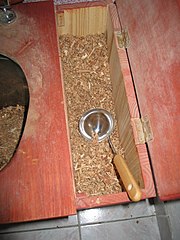Composting toilet
From Wikipedia, the free encyclopedia
A composting toilet is a closed unit, not connected to a sewage system or septic tank, used to receive, contain, and compost human waste via aerobic biodegradation[1] or by dessication[2]. In replacing a standard flush toilet the purpose of these units is the conservation of water resources otherwise used for flushing, while avoiding release of potentially pathogenic materials into the environment, and conserving useful nutrients for fertilizing home gardens (see ecological sanitation). There are a number of commercial units widely available, and DIY plans are common.[3]
For other small scale systems of human waste handling, and outdoor ('Outhouse' or 'Dunny') styles of toilets see latrine, pit latrine, and arborloo or tree bog, all of which are forms of less controlled psychrophilic or mesophilic decomposition, and may not protect ground water from nutrient or pathogen contamination, provide optimum nutrient recycling, or be appropriate in urban settings.
Contents |
[edit] Types
Manufactured
Self-contained composting toilets complete the composting in a container within the receiving fixture. Remote units transport the waste to a composting chamber below the toilet by gravity, but vacuum-flush systems can flush horizontally or upward, and there are commercial systems that use a small amount of water ("micro-flush"), usually 1 pint (.5 litre) per use. All share the characteristic of being continuous processors: waste material in the top, finished compost out at the bottom, with no interruption of the process and minimal exposure to unprocessed material.
Single unit self-contained composting toilets are slightly larger than a flush toilet, but use roughly the same floor space. Some units use electricity (AC or DC, solar) to aid the composting process with fans for air circulation, and optionally, heating elements to maintain optimum temperatures for thermophilic decomposition. Most composting toilets have an absorbent organic high-carbon material (commonly sawdust) added periodically to absorb liquid and maintain aeration ("bulking agent") in the mass as it collects, and some makers supply microbial "starter" cultures. Remote style composting toilets have a chamber below the toilet fixture (in a basement, or sheltered outside) where the composting action takes place. These separate remote compartments require much more space, and are intended for heavier use or multiple toilets. Different designs are also available, like the Clivus Multrum (an inclined remote type)[4], which uses low-temperature decomposition, where the waste is left for longer periods in a large collector, and the dry solar toilet, which uses urine separation and solar aided drying.[5] Many different brands are available in North America, across Europe and the UK, and Australasia.

Composting toilets are intended primarily for the processing of excrement, toilet paper, and the carbon additives such as sawdust. Generally it's not advisable to add other compostable organic waste, although small amounts of kitchen food waste will be acceptable in an active system - note that inclusion of large amounts of food waste can easily result in populations of soldier fly, fruit flies and fungus gnats where few would want them. Manufactured systems will generally be designed to conform to the American National Standard/NSF International Standard ANSI/NSF 41-1998: Non-Liquid Saturated Treatment Systems.[6]
DIY

Home made indoor composting toilets use a collector bucket, where each addition is covered with sawdust or other dry organic material, with the collector periodically being hand transported to an outdoor composting bin, where it may be added to yard waste or other organic material being composted. These units (batch systems) may be as simple or complex as the owner desires, from a seat-topped pail to elaborate hand-crafted furnishings like Moule's "earth closet" pictured here, with semi-automatic cover material additions.
Other "site-built" units are often along the lines of the "no effort" outhouse styles commonly found in rural areas world-wide, particularly in less developed nations. Properly designed, and in conjunction with an understanding of the principles of composting, they can be instrumental in improved local public health, disease prevention, preventing ground water pollution, and are promoted by various development agencies and NGO's.[7]
Public Use
Increasingly, compost-toilet systems have begun to compete with and replace conventional water closets in high-use public facilities. One example is the three-storey C.K. Choi Building at the University of British Columbia (Canada), which contains 5 compost chambers with 12 toilets for 300 full-time employees.[4] IslandWood School[8] on Bainbridge Island, WA (USA), relies primarily on compost toilets. They may also be found in various places around Europe, such as the roadside facilities in Sweden pictured here.
Composting toilets greatly reduce the volume of humanure on site through thermophilic or mesophilic composting and yield a fertilizer that can be used in horticultural or agricultural applications as local regulations allow. Composting toilets are becoming more common as an accepted alternative in parks and schools, where the operation of a properly functioning unit promotes water conservation and sewage reduction goals, allowing for public toilet facilities under drought circumstances or in areas that lack water and sewerage utilities, an important application for the technology in areas all over the world where there is only periodic availability of water.
[edit] Operating process
Although there are many different specific designs, the principles involved are basic, and universal to natural biochemical processes. Rapid aerobic composting will be thermophilic decomposition in which bacteria that thrive at high temperatures (40-60 °C / 104-140 °F) oxidize (break down) the waste into its components, some of which are consumed in the process, reducing volume, and eliminating potential pathogens.
Partial urine diversion, where excess urine is redirected via a separate drain in the collector tray, is found in some commercial units, as the aerobic composting process requires moisture levels to be controlled (ideally 50% +/- 10): too dry, and the mass decomposes slowly or not at all; too wet and anaerobic organisms thrive, creating undesireable odors (cf. Anaerobic digestion). This separated liquid may be diverted to a gray water system or collected for other uses. Urine contains approximately half of the available plant nutrients (usually more than 80% of the N (nitrogen), 60% of the P (phosphorus) and 70% of the K (potassium))[9] in human waste, and in healthy individuals is microbially sterile, although undiluted it may contain levels of inorganic salts and organic compounds at levels toxic to plants.
A slightly different approach that is becoming more common is the "dry" toilet, or total urine separation system, also known as the "solar" toilet where solar heat gain is leveraged to aid the process.[10] These systems depend on dessication to achieve sanitation safety goals[11], and make use of the separated (nutrient rich) liquid fraction for immediate area fertilization
The other requirement critical for microbial action (as well as drying) is ample oxygen. Commercial systems provide methods of ventilation that move air from the room, through the waste container, and out a vertical pipe, venting above the enclosure roof. This air movement (via convection or fan forced) will keep room odors from developing in a properly functioning unit.
Most units provide/require manual methods for periodic aeration of the solids mass such as rotating a drum inside the unit or working an "aerator rake" through the mass. Compost toilet brands have different provisions for emptying the "finished product", and supply a range of capacities based on volume of use. Frequency of emptying will depend on the speed of the decomposition process and capacity, from a few months (active hot composting, self-contained) to years (passive, cold composting, large chamber). With a properly sized and managed unit, a very small volume (about 10% of inputs) of a humus-like material results, which will be suitable as an organic matter/fertilizer for agriculture - depending on local public health regulations. Many vendors will provide help regarding regulations and permitting, where required
[edit] Manufacturers
List of manufacturers (representative, not exhaustive):
|
|
|
[edit] See also
|
[edit] References
- ^ US EPA "Fact Sheet: Composting Toilets"
- ^ A study of single-vault, solar composting systems
- ^ National Small Flows Clearinghouse, West Virginia University, Composting toilet technology
- ^ a b C. K. Choi Building for the Institute of Asian Research
- ^ Dry Composting Toilet Demonstration Project
- ^ EPA on ANSI/NSF standard
- ^ Fossa alterna DIY plans for Developing Areas
- ^ IslandWood outdoor learning center
- ^ J.O. Drangert, Urine separation systems
- ^ Dry Composting Toilet Demonstration Project
- ^ A study of single-vault, solar composting systems "Survival of Fecal Coliforms in Dry-Composting Toilets"
[edit] External links
- Alternative Sanitation
- Sustainable Sanitation Alliance (susana.org)
- Reuse of faeces and urine
- Humanure Handbook online (PDF also available)
- Practical Action's guide on building DIY composting-toilets
- "What is a Composting Toilet System and How Does it Compost?"
|
||||||||||||||
|
|||||||||||||||||||||||||||||||||||||||||||||||||||||||||||||||||||





